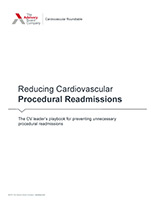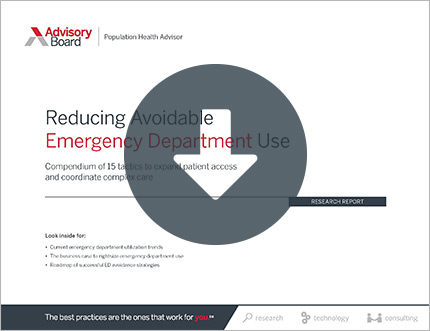Editor's note: This popular story from the Daily Briefing's archives was republished on Jan. 23, 2019.
A pilot program at Intermountain Healthcare that empowers family members to help care for their loved ones enhanced care for patients—and cut readmissions among participants by 65%, according to a study in CHEST.
Here are the 15 tactics to reduce avoidable ED utilization
How it works
For the study, nurses informed the family members of patients about the pilot program, called Partners in Healing, and invited them to participate. Nurses then taught those who opted in a handful of basic skills related to the specific needs of the patient. Participants received a badge that indicated to the staff that they were part of the care team, entitled to access blankets, drinks, ice, and snacks on behalf of the patient.
Staff then taped a checklist to the patient's door, where participants recorded their contributions to the patient's care, such as helping the patient go to the bathroom, performing breathing exercises, or measuring urine output. The nurse then input the data from the checklist into the patient's computer record.
The tasks participants can perform were pre-determined by the patient's care needs and the family member's capacity as a caregiver, HealthcareFinance reports. The tasks given to the family members were simple, "but they give families a sense of control and knowledge about what they can and can't do," Michelle Van De Graaff, an RN at Intermountain Medical Center who created the pilot program and led the study, said.
Positive results
For the study, researchers compared about 200 adult heart surgery patients who had family members participating in the program with a control group whose family members did not participate in the program. The researchers assessed:
- 30-day all-cause readmissions;
- 30-day all-cause mortality;
- Length of stay; and
- Number of ED visits.
After controlling for age, gender, and severity of illness, the researchers found that 30-day readmission rate was 65% lower among patients whose families participated in the program than among those whose loved ones did not.
The researchers did not find any significant differences in other metrics.
The researchers also garnered participant feedback and found that 92% of the patients whose family members participated in the program said it helped their transition from hospital to home—and 94% of family members said they'd recommend the program to other families. Further, family members said they acquired relevant caregiving skills and felt empowered and integrated into the care team, curbing their feelings of anxiety and helping them participate in the patient's recovery at home. Families recommended that Intermountain integrate the program for all patients at all phases of care, including intensive care.
"The vast majority of families like to have something to do and they like to participate in patient care. They're often the most motivated member of the care team," Van De Graaff said in a statement. "We've found that families not only want to promote healing, but patients benefit from someone who knows their preferences, and the result is, the rate of readmissions is reduced after patients are discharged from the hospital."
Intermountain has announced that it intends to expand the program from the seven acute-care facilities where it was piloted to all other 21 facilities. Mayo Clinic has also implemented the program, according to Patient Engagement HIT (Lagasse, Healthcare Finance, 2/13; Science Daily, 2/12; Heath, Patient Engagement HIT, 2/12; Knowles, Becker's Hospital Review, 2/14).
Here are the 15 tactics to reduce avoidable ED utilization
Learn about current emergency department utilization trends, understand the business case to rightsize emergency department use, and get a roadmap of successful ED avoidance strategies.
Don't miss out on the latest Advisory Board insights
Create your free account to access 2 resources each month, including the latest research and webinars.
Want access without creating an account?
You have 2 free members-only resources remaining this month remaining this month.
1 free members-only resources remaining this month
1 free members-only resources remaining this month
You've reached your limit of free monthly insights
Become a member to access all of Advisory Board's resources, events, and experts
Never miss out on the latest innovative health care content tailored to you.
Benefits include:
You've reached your limit of free monthly insights



